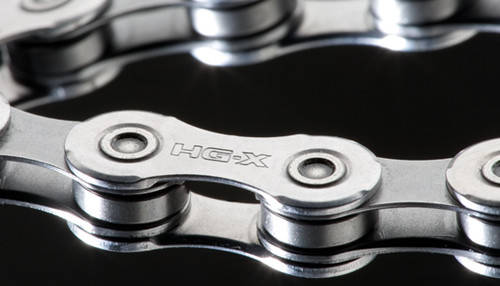
After the last Chainwear Challenge post, there were a couple questions that had risen mainly about the stock grease or lube that Shimano uses and differences between the construction of 9 vs 10 speed chains. At the end of my time at the Shimano XT press camp, I took the opportunity to ask one of Shimano’s main tech gurus, Nick Murdick, those very questions to get the official answer straight from the source.
So should you keep the factory chain lube? Are there notable differences between 9 speed and 10 speed chain construction?
Check out my short interview with Nick after the break!
BikeRumor: Are there any critical differences between the construction of a 9 and 10 speed chain that may cause a difference in wear and longevity? Other than the Dyna-Sys chains being asymmetrical, of course.
Nick: There are a lot of things that affect the lifespan of a chain. Chains are a system of outer plates held to inner plates via a pin that is firmly attached to the outer plate, loosely attached to the inner plate and a roller that holds the two inner plates apart. Chains stretch when the hole in the inner plate gets bigger, this allows the rollers to get further apart from each other. The rollers also wear. Their thickness is reduced as the inside of the roller is worn away. The rollers are the interface between the chain and the gear, so if they get worn the chain will want to sit lower on the gear where the pitch of the chain does not match the pitch of the gear. The inner plates and rollers wear down from friction as the individual links move to wrap around a gear. The smaller the gear, the more a chain link has to move to wrap around it. The Dyna-Sys drivetrain tends to keep you on bigger gears in both the front and the back so this effect is reduced. As a chain wears and stretches the chain will try to grind down the teeth on a gear to make its tooth to tooth distance match the chain’s new roller to roller distance. A larger gear will be able to resist this effect so cassettes and granny gears are actually more durable as well.
You mentioned the asymmetrical chain, which is certainly a factor. Another important factor in the life of a chain is the amount of stress it is under. The asymmetrical chain with specific front shifting plates on the outside, combined with ramps on the chainring that are specifically designed to work with that new chain shape significantly reduces the amount of stress on the chain during a front shift. In addition, the chain is actually a mountain bike specific chain. The outer plates on the outboard side are designed to resist twisting forces encountered during hard front shifts on a mountain bike. There is also material removed from the back sides of the outer link plates on both sides to improve mud shedding. The clearance between the outer plates is actually very similar on 9 and 10 speed chains even though the 10 speed chain is narrower.
There is also a new production process which increases the strength of the chain. The plates are forged in a new way that allows for a better interface between the inner and outer plates. This is a big part of the reason we are able to make a narrower 10 speed chain just as strong as a 9 speed chain.
BikeRumor: What is Shimano’s official stance on the chain lube that comes stock on a shimano chain? Is it actually a lube, or a grease? And is it best to leave it on until the chain gets noisy and relube, or strip it right away and relube before riding?
Nick: So that brings us to lubrication. I mentioned that the chain wears because of friction as the chain moves to wrap around a gear. Well, that friction is reduced if there is lube on the chain. If there is dirt mixed in, the lube makes a bigger difference in reducing friction. If there is water mixed in, the lube helps displace the water. The grease that comes on a Shimano chain is applied at the factory to the individual pieces before the chain is assembled. The grease does a better job of reducing friction than aftermarket chain lubes and it lasts longer. The main reason we use liquid chain lube, whether it is one that stays liquid or a dry lube that has a solid lubricant in a liquid carrier (like a PTFE lube) is because we need to get the lube on a part that is not accessible without disassembling the chain. So the best thing to do when installing a new chain is to leave the factory grease on, not apply any other lube, ride until it wears out and then start applying liquid chain lube. In dusty conditions you can wipe off the outside of the new chain with a rag that is wet with a gentle degreaser to keep dirt from sticking to the grease. The factory grease also keeps the chain nice and quiet. After soaking a chain in degreaser and then lubing the chain with liquid lubricant the chain gets noticeably louder.
Shimano does not have an official recommended chain lube. They all seem to work pretty good. Different people have different preferences and different conditions require different lubes.
So there you have it. You absolutely should leave the original chain grease in place for best performance, and there are differences in construction that were necessary to make up for the narrower 10 speed chain. So far, those differences seem to be working as the 10 speed groups are still slightly better as far as wear, but it will be interesting to see how it plays out in the end!